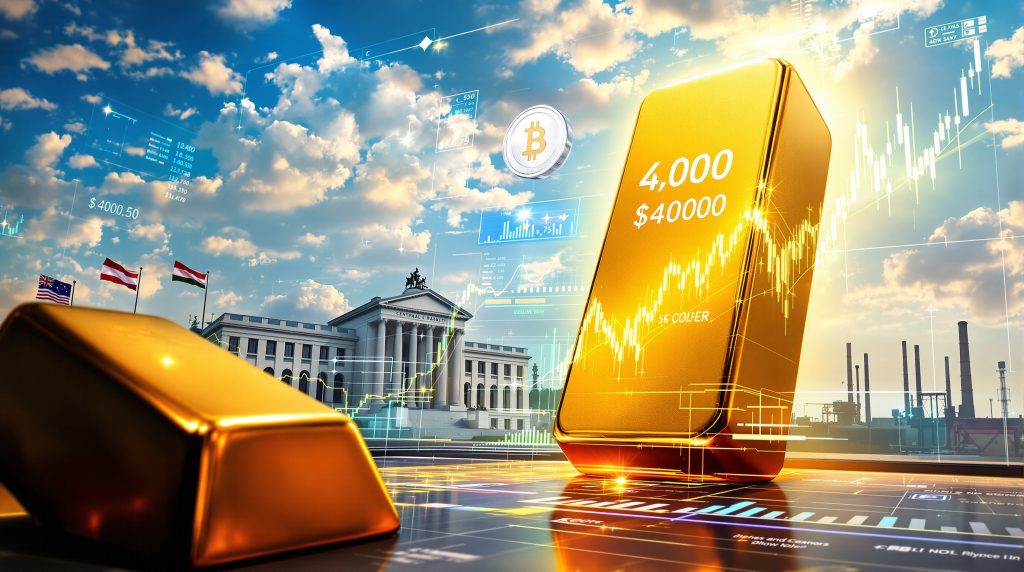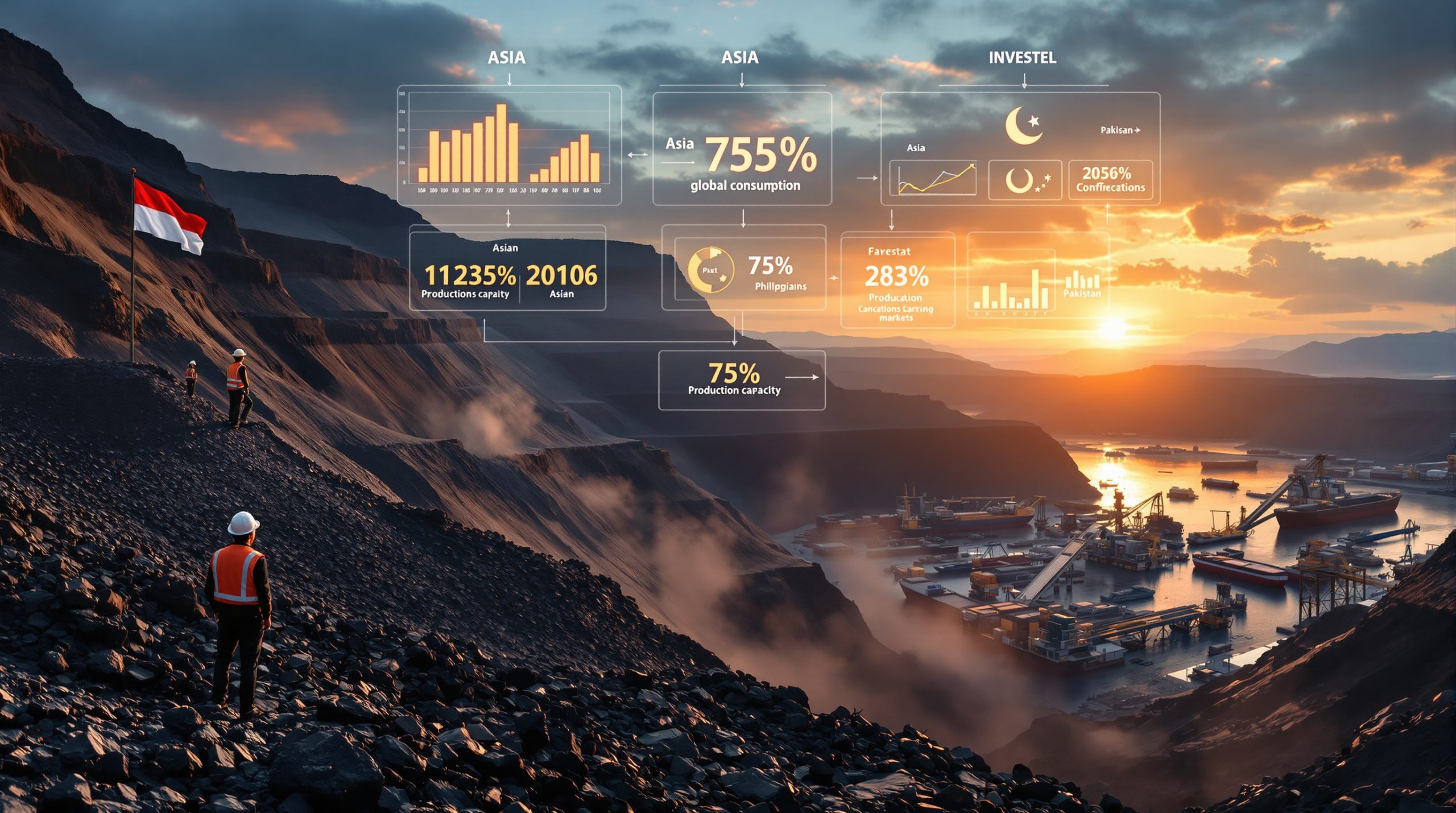What's Driving Gold's Record-Breaking Price Rally?
Gold has surged beyond the $4,000 per ounce threshold for the first time in history, marking an unprecedented rally that has captivated investors worldwide. This meteoric rise represents gold's 40th record price milestone in 2025 alone, demonstrating the exceptional momentum behind precious metals in today's uncertain economic landscape.
Global Economic Uncertainty as a Catalyst
The current gold price surge stems from a perfect storm of economic and geopolitical factors creating significant market anxiety. As inflation concerns persist across major economies despite central bank interventions, investors have increasingly sought refuge in traditional safe-haven assets.
Political tensions across several key regions have amplified market uncertainty. The ongoing questions surrounding Federal Reserve policy independence under the Trump administration have further fueled concerns about monetary stability and long-term inflation protection.
The weakening confidence in traditional currency markets has become particularly evident as the US dollar faces mounting pressure. According to the Federal Reserve Economic Data (FRED), real interest rates (nominal rates minus inflation) continue to show an inverse correlation with gold prices, supporting the metal's fundamental appeal.
Central Bank Buying Reaches Unprecedented Levels
The World Gold Council's Q3 2024 report reveals central banks added an impressive 694 tonnes to global reserves in just the first nine months of 2024. This follows the record-breaking purchases of 1,082 tonnes in 2023, demonstrating a clear strategic shift among monetary authorities worldwide.
This unprecedented central bank participation represents a structural market transformation rather than a cyclical trend. Emerging market central banks have led this strategic diversification away from dollar-denominated reserves, seeking to reduce dependence on any single currency.
The Bank for International Settlements notes this trend represents the most significant reshaping of central bank reserve assets in decades, with gold's proportion of reserves reaching levels not seen since the 1980s.
Investment Demand Transformation
Institutional investors have dramatically increased their precious metals allocations, with ETF inflows showing substantial year-over-year growth. Physical gold demand has simultaneously surged across both retail and institutional sectors, creating multi-channel buying pressure.
Perhaps most remarkably, gold has doubled in value from its levels two years ago, climbing from approximately $2,000 to beyond $4,000 per ounce. This acceleration reflects a fundamental shift from tactical to strategic allocation in investment portfolios.
Financial institutions have responded by revising their outlook, with Goldman Sachs projecting gold could reach nearly $4,900 per ounce by December 2025. This bullish stance reflects growing recognition of structural factors supporting higher prices rather than speculative fervor.
How High Can Gold Prices Go?
The breaking of the psychological $4,000 barrier has many market participants questioning where the ceiling might be for this historic rally. While predictions vary widely, certain frameworks help provide context for potential price trajectories.
Major Financial Institution Forecasts
Goldman Sachs leads the bullish camp with their projection of nearly $4,900 per ounce by December 2025. Their analysis cites structural market tightening, persistent inflation concerns, and accelerating central bank purchases as primary drivers.
Standard Chartered has highlighted the fundamental shift in market dynamics, noting that unlike previous rallies, today's gold market benefits from synchronized buying across institutional, central bank, and retail channels. Their analysts point to diminished selling pressure as a key factor supporting sustained higher prices.
Historical comparisons provide essential context—gold's 1980 peak of $850 translates to approximately $3,200-3,400 in today's dollars when adjusted for inflation. Similarly, the 2011 high of around $1,900 equates to roughly $2,600-2,700 in 2025 dollars using CPI adjustments. With prices now exceeding $4,000, gold has established genuine inflation-adjusted all-time highs according to comprehensive gold price analysis.
Key Price Milestones and Technical Analysis
The breakthrough above $4,000 represents more than just a psychological barrier—it establishes new technical territory without historical resistance levels. Recent trading has seen gold reach $4,049 before settling slightly lower, indicating potential consolidation at these elevated levels.
Volume indicators reveal robust participation across major exchanges, with COMEX gold futures open interest remaining elevated despite the price surge. This suggests institutional commitment rather than speculative excess typically associated with market tops.
Technical support levels have progressively strengthened, with previous resistance at $3,800-3,850 now functioning as potential support. The 50-day moving average has maintained a healthy distance below spot prices, indicating strong momentum.
Warning Signs of Market Overextension
Despite the robust fundamental backdrop, several indicators suggest caution may be warranted. The Relative Strength Index (RSI) for gold has approached overbought territory on multiple timeframes, historically a precursor to short-term corrections.
The unusual correlation between gold and equities at current levels diverges from traditional intermarket relationships. Typically, gold and stocks demonstrate inverse correlations during periods of market stress, but recent months have seen concurrent strength across asset classes.
Historical precedents from previous gold bull markets (1979-1980, 2009-2011) suggest significant corrections frequently follow periods of parabolic price appreciation. While structural factors today differ markedly from these previous episodes, prudent investors should consider potential consolidation scenarios as outlined in recent gold price forecast reports.
Why Is Silver Outperforming Gold in the Current Rally?
While gold has captured headlines, silver has quietly delivered even more impressive performance, reflecting its unique market dynamics and investment characteristics.
Silver's Dual-Nature Advantage
Silver's performance has been truly remarkable, reaching a record $49.55 per ounce and breaking through its previous all-time high established in January 1980. This milestone comes as silver's dual role as both precious metal and industrial commodity creates amplified price pressure.
Silver futures have climbed 3.2% to $49.20 in New York trading, contributing to an astonishing 65% appreciation year-to-date that has outpaced even gold's impressive gains. This outperformance highlights silver's traditionally higher volatility and beta relative to gold.
The industrial components of silver demand create additional price drivers beyond investment flows. As electrification and renewable energy deployment accelerate globally, silver's critical role in electronics, photovoltaics, and medical applications provides fundamental support beyond monetary factors.
Supply-Demand Fundamentals
Market tightness in physical silver has become increasingly evident. The London Bullion Market Association (LBMA) reports rising lease rates for silver, indicating a premium for immediate physical delivery versus future settlement. This premium typically emerges when supply constraints meet strong demand.
COMEX silver inventories have reached significant levels, yet paradoxically, this can indicate market tightness when much of this metal is already allocated or spoken for rather than freely available. Standard Chartered analysts note this apparent contradiction reflects strong demand removing metal from available supply.
Indian silver consumption continues to provide substantial support, with the India Bullion and Jewellers Association reporting sustained buying despite higher prices. India traditionally represents one of the world's largest silver markets, with both investment and industrial applications contributing to the ongoing silver market squeeze.
Silver-to-Gold Ratio Implications
The silver-to-gold ratio (the number of silver ounces required to purchase one ounce of gold) has compressed from historically elevated levels, suggesting silver's relative undervaluation may be correcting. The ratio has moved from approximately 85:1 earlier in the year to closer to 80:1 currently.
Historical analysis suggests silver typically outperforms gold during precious metals bull markets, particularly in later stages. The current ratio remains above long-term historical averages of roughly 60:1, potentially indicating further upside for silver relative to gold.
For investors, silver's relative valuation presents both opportunity and risk—while offering potentially higher returns, silver historically exhibits substantially greater volatility, with price swings of 3-4% in a single day not uncommon during active markets.
How Are Base Metals Responding to the Precious Metals Rally?
While precious metals have led recent commodity market strength, base metals—particularly copper—have shown impressive gains of their own, driven by distinct but complementary factors.
Copper's Synchronized Price Surge
Copper has climbed to a 16-month high of $10,815 per ton on the London Metal Exchange, while US futures have pushed even higher to $11,343. This strength reflects copper's unique position at the intersection of industrial demand, supply constraints, and investment flows.
Technical analysis reveals copper breaking through significant resistance levels established during previous 2023-2024 trading ranges. Volume indicators suggest renewed investor interest complementing industrial buying, creating multi-channel demand.
Market participants increasingly recognize copper's essential role in the global energy transition, with electric vehicles requiring up to four times more copper than conventional vehicles, and renewable energy installations needing significantly higher copper intensity than traditional power generation.
Production Challenges Creating Supply Shortfalls
Teck Resources has slashed its 2025 production forecast for copper to 170,000-190,000 tons, down significantly from previous guidance of 210,000-230,000 tons. This reduction stems from operational challenges at its Quebrada Blanca mine in Chile and Highland Valley Copper operation in Canada.
These production setbacks occur against a backdrop of broader global supply challenges. Major disruptions across Chilean operations—responsible for approximately 28% of global copper production—have tightened market conditions. Similar issues in the Democratic Republic of Congo and Indonesia have further constrained global supply.
The extended downtime at Quebrada Blanca relates to tailings dam remediation work, highlighting the increasing regulatory and environmental considerations affecting mining operations worldwide. These factors create structural rather than temporary supply limitations.
2025-2026 Production Forecast Revisions
Production forecasts for 2025-2026 have seen significant downward revisions. Teck Resources now projects unit costs could reach up to $3 per pound next year before potentially stabilizing as production recovers. These cost increases reflect both operational challenges and broader inflationary pressures in the mining sector.
The implications for global copper supply extend well beyond individual company performance. With analysts forecasting copper price prediction could exceed $12,000 per ton next year, the strategic importance of the metal for energy transition goals becomes increasingly evident.
The International Energy Agency estimates copper demand for clean energy technologies could grow by over 40% by 2030, precisely when supply constraints appear most acute. This timing mismatch creates both challenges for green technology deployment and opportunities for upstream producers.
What Are the Investment Implications of the Precious Metals Surge?
The historic rally in precious metals presents both opportunities and challenges for investors seeking to optimize portfolio performance while managing associated risks.
Portfolio Allocation Strategies
Traditional portfolio theory suggests allocations of 5-10% to precious metals as an inflation hedge and diversifier. However, the structural shifts currently underway may warrant reassessment of these conventional guidelines.
JPMorgan Asset Management's latest Global Market Outlook suggests investors consider incremental increases to precious metals allocations, particularly for portfolios with extended time horizons and moderate risk tolerance. Their analysis indicates gold's traditional negative correlation with equities during stress periods maintains its diversification benefits.
Balancing physical holdings versus mining equities requires careful consideration of risk preferences and investment objectives. Physical metals typically offer lower volatility but no yield, while mining companies provide operational leverage to metal prices but introduce company-specific risks and potential dividend income.
Mining Sector Investment Opportunities
The divergence between major producers and junior exploration companies has widened during the current rally. Large-cap miners benefit from established production and cash flow, while junior explorers offer higher speculative potential but with substantially increased risk profiles.
Geographic diversification across mining jurisdictions has become increasingly important as resource nationalism and regulatory complexity grow worldwide. The Fraser Institute's Annual Survey of Mining Companies provides valuable insights into jurisdiction risk, with Australia, Canada, and parts of the United States consistently ranking among the most favorable regions.
Production cost analysis reveals significant variation across the industry. Companies with all-in sustaining costs (AISC) below $1,200-1,500 per ounce for gold position themselves for substantial margin expansion in the current price environment, potentially supporting dividend growth and capital returns.
Alternative Exposure Methods
Royalty and streaming companies present an interesting middle ground between physical metals and mining equities. These businesses provide upfront capital to miners in exchange for the right to purchase future production at predetermined prices, offering inflation protection with reduced operational risk.
Options strategies can help manage precious metals volatility, with covered calls potentially enhancing yield during sideways markets and protective puts limiting downside during corrections. The Chicago Board Options Exchange (CBOE) reports increased options activity across metals-related products as investors seek to manage price volatility.
The distinction between physical and paper gold becomes particularly important in periods of market stress. While ETFs like SPDR Gold Shares (GLD) offer convenience and liquidity, they introduce counterparty and systemic risks absent from allocated physical holdings. This trade-off requires careful consideration based on individual risk tolerance and objectives, as explained in the comprehensive gold stock market guide.
How Is the Resource Sector Consolidation Landscape Evolving?
The elevated commodity price environment has accelerated consolidation activity across the resource sector, with implications for supply, competition, and investment opportunities.
Major Merger and Acquisition Activities
The $53 billion Anglo American merger represents one of the industry's most significant consolidation moves. Despite production challenges at key operations, the strategic rationale for scale and operational diversification remains compelling in today's resource market.
Integration timelines typically extend 12-18 months for major mining mergers, with synergy realization often taking even longer. S&P Global Market Intelligence reports that approximately 60% of mining sector mergers fail to achieve their initially projected synergies within the announced timeframe.
Regulatory approval processes have grown increasingly complex, particularly for cross-border transactions involving critical minerals. Recent precedents suggest heightened scrutiny from competition authorities and national security reviews, potentially extending approval timelines.
Cross-Sector Expansion Strategies
Kazakhstan's Fincraft Group exemplifies the trend toward cross-commodity integration, expanding from mining into oil and gas through its proposed acquisition of Toronto-listed Tatus Petroleum. This strategic shift reflects recognition of the interconnected nature of resource sectors.
The billionaire chairman behind Fincraft has pivoted from technology investments toward building an integrated industrial network, incorporating nickel, cobalt, coal, and gold assets. This strategic repositioning aligns with broader trends of resource consolidation in Central Asia.
The integration of mineral and energy production under unified corporate structures offers potential operational synergies, improved capital allocation, and enhanced market positioning. PwC's annual mining industry review identifies this cross-sector integration as an emerging trend among resource conglomerates.
Regional Resource Control Dynamics
Central Asian resource consolidation has accelerated as nations seek greater economic security and bargaining power in global markets. This regionalization of resource control mirrors similar developments in other resource-rich regions like South America and Africa.
The shift from technology investments to industrial network development reflects changing perceptions of strategic value in a resource-constrained world. McKinsey & Company's research on resource security highlights the growing importance of vertically integrated supply chains in critical minerals.
Geopolitical considerations increasingly influence resource sector investments, with national security and supply chain resilience often trumping purely economic factors. The resulting premium for assets in politically stable jurisdictions has implications for valuation models and investment strategies.
What's the Outlook for Precious Metals in Coming Months?
While predicting short-term price movements remains challenging, several key indicators and seasonal patterns provide context for potential precious metals performance in coming months.
Key Indicators to Monitor
Federal Reserve policy decisions will remain central to precious metals performance. Current market expectations incorporate potential rate adjustments through 2026, with particular focus on the trajectory rather than individual decisions. The Federal Reserve's own Summary of Economic Projections provides valuable insights into this outlook.
Dollar strength relative to major currency baskets has historically shown strong inverse correlation with gold prices. The US Dollar Index (DXY) currently sits at levels that continue to support the precious metals narrative, though significant strengthening could provide headwinds.
Inflation data across major economies warrants close attention, with the Bureau of Labor Statistics' monthly CPI releases and the Federal Reserve's preferred PCE inflation gauge serving as primary indicators. The divergence between headline and core measures provides additional nuance for precious metals positioning.
Geopolitical flashpoints continue to influence safe-haven demand, with ongoing tensions in several regions supporting the risk premium embedded in precious metals pricing. Reuters, Bloomberg, and the Financial Times provide comprehensive coverage of these developments.
Seasonal Factors and Historical Patterns
Traditional demand cycles in precious metals markets typically show strength in the September-November period, followed by potential year-end positioning adjustments. The World Gold Council's historical data confirms this seasonal pattern, though structural factors may override cyclical tendencies in the current environment.
Indian wedding season (October-December) traditionally drives strong physical gold demand, particularly in years with favorable monsoon conditions supporting agricultural incomes. The current season appears supportive based on preliminary data from the India Bullion and Jewellers Association.
Chinese New Year preparations beginning in January typically support gold demand in the world's largest physical market. The interaction between Chinese economic conditions, consumer sentiment, and traditional buying patterns merits careful monitoring as this period approaches.
Expert Consensus and Divergent Viewpoints
The bull case for precious metals rests on continued central bank buying, persistent inflation concerns, and geopolitical uncertainty. Goldman Sachs leads this camp with their near-$4,900 per ounce gold target by December, supported by structural market analysis.
Bear case considerations include potential monetary policy normalization, dollar strength scenarios, and the historically extended nature of the current rally. While less prevalent, these perspectives emphasize technical overextension and the potential for mean reversion.
Consensus price targets for year-end cluster in the $4,500-4,800 range according to the most recent Bloomberg survey of precious metals analysts, though individual forecasts vary significantly. This dispersion itself indicates the unusual nature of current market conditions.
Volatility expectations have increased alongside prices, with the CBOE Gold Volatility Index (GVZ) reflecting heightened uncertainty. Risk assessment frameworks suggest maintaining risk management disciplines despite bullish fundamentals, particularly for leveraged exposure.
FAQ: Gold Price Surge and Market Implications
Is gold currently in a bubble market?
Gold's rapid price appreciation has raised legitimate questions about potential bubble conditions. Several technical indicators suggest market extension beyond historical norms, with momentum measures reaching levels previously associated with temporary tops.
However, fundamental drivers including record central bank buying, persistent inflation concerns, and genuine geopolitical tensions provide substantial support for elevated prices. Unlike purely speculative bubbles, the current gold price surge demonstrates broad-based participation across institutional, central bank, and retail channels.
The inflation-adjusted context provides additional perspective—while nominal prices have doubled over two years, gold remains less extended relative to historical precedents when accounting for cumulative inflation since previous bull markets, according to recent reports.
How does the current gold rally compare to previous bull markets?
The present gold bull market features unprecedented central bank participation, with official sector buying far exceeding levels seen during the 1980 or 2011 rallies. The World Gold Council's historical data confirms central banks have transitioned from net sellers to significant net buyers over the past decade.
Unlike previous cycles driven primarily by inflation fears (1980) or financial crisis (2008-2011), today's market shows broader structural shifts in allocation strategies. Institutional adoption has expanded significantly, with gold increasingly viewed as a strategic rather than tactical portfolio component.
The breaking of inflation-adjusted historical highs provides clear differentiation from previous rallies, which peaked at lower real prices. This suggests fundamental rather than purely cyclical or speculative factors at work in the current environment.
Should investors consider silver instead of gold at current prices?
Silver's outperformance of gold (65% vs. 50% year-to-date) reflects its traditional higher beta and volatility characteristics. This dual-natured metal typically amplifies precious metals price movements in both directions, making it suitable for investors with higher risk tolerance and conviction in continued bullish conditions.
The industrial component of silver demand adds complexity but potentially higher upside in continued economic growth scenarios. The Silver Institute identifies photovoltaics, electronics, and medical applications as particularly strong demand drivers in the current environment.
Investors should recognize silver's historical volatility can exceed gold's by a factor of two or more. This characteristic makes silver potentially more rewarding during bull markets but substantially more punishing during corrections. Position sizing should reflect this fundamental difference in risk profile.
How might copper supply challenges affect green energy transition goals?
The significant production shortfalls at major copper mines create substantial headwinds for green energy deployment schedules. The International Energy Agency estimates that electric vehicles require 2-4 times more copper than conventional vehicles, while solar and wind installations need 4-5 and 2-3 times more copper per megawatt than fossil fuel generation, respectively.
With forecasts suggesting copper prices could exceed $12,000 per ton next year, renewable energy project economics face increased pressure. Higher material costs may delay marginal projects or require additional subsidies to maintain deployment trajectories aligned with climate goals.
The timing mismatch between accelerating demand and constrained supply creates strategic challenges for governments and companies committed to energy transition timelines. This dynamic has implications for policy frameworks, technology choices, and investment priorities across the clean energy landscape.
Ready to Capitalise on the Next Major Gold Discovery?
Discover why major mineral discoveries can lead to significant market returns by exploring Discovery Alert's dedicated discoveries page, showcasing historic examples of exceptional outcomes powered by their proprietary Discovery IQ model. Begin your 30-day free trial today to position yourself ahead of the market when the next major gold discovery is announced.




